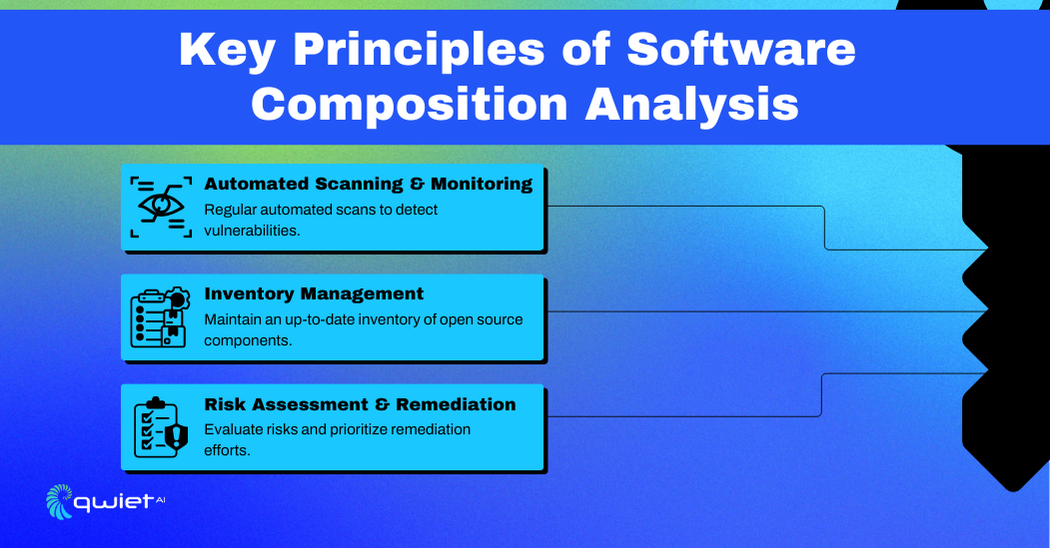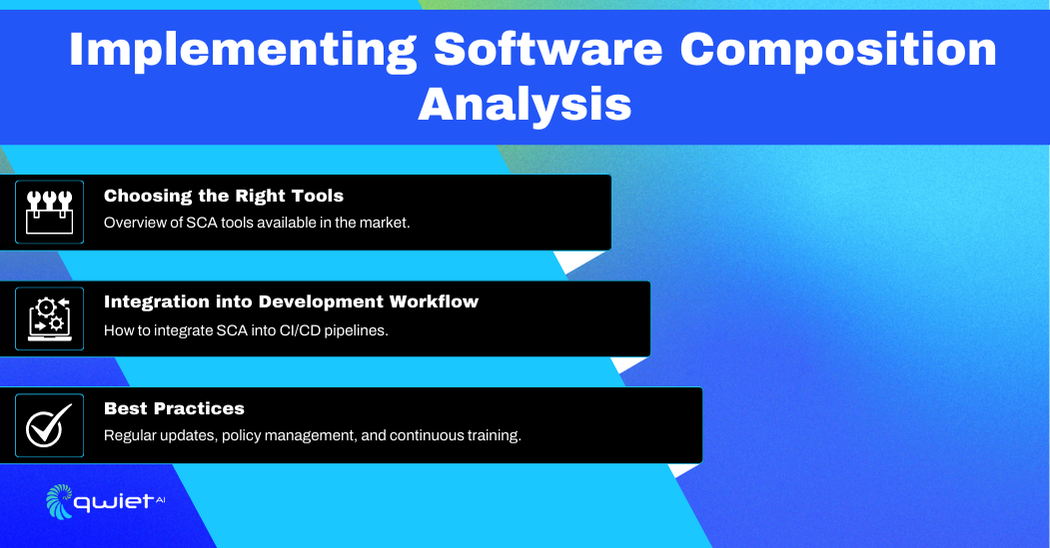What is Software Composition Analysis?
Software Composition Analysis (SCA) is a method used to identify and manage the open-source components in your software. It helps developers track the components, licenses, and associated vulnerabilities, providing a clear picture of what third-party code is used in a project.
SCA is becoming increasingly important in modern software development due to the widespread use of open-source libraries. These components save time and resources but can also introduce vulnerabilities and licensing risks. SCA helps mitigate these risks by providing visibility into your open-source code, making it easier to manage and secure.
SCA tools scan your codebase to identify open-source components and their associated metadata, such as versions, licenses, and known vulnerabilities.
They cross-reference this information with vulnerability databases to alert you of potential security or compliance risks. This automated approach helps you maintain a secure and compliant codebase while leveraging the benefits of open-source software.
Why Software Composition Analysis is Important
Open source components are now a fundamental part of most software projects. Developers rely on these libraries to accelerate development, reduce costs, and avoid reinventing the wheel. However, with this widespread adoption comes the challenge of effectively managing and securing these components.
SCA is crucial in helping developers track which open-source components are being used in their projects. It provides detailed insights into these components’ licenses, versions, and potential vulnerabilities, enabling teams to manage them effectively and avoid security and compliance issues.
SCA tools are designed to scan your codebase and identify known vulnerabilities in the open-source libraries you’re using. By cross-referencing your components against regularly updated vulnerability databases, SCA helps you stay informed about any security risks associated with your project’s libraries.
Principles of Software Composition Analysis

Automated Scanning and Monitoring
Automated scanning tools are integrated into the continuous integration (CI) pipeline to keep your software secure. These tools scan your codebase regularly as part of the development process, catching vulnerabilities early and ensuring that any new code or updates don’t introduce security issues.
Automated tools help maintain the security of your software over time by continuously scanning for vulnerabilities. They monitor your codebase for changes or additions and quickly identify potential risks, allowing you to address them before they can cause harm.
Inventory Management
Keeping an accurate and up-to-date inventory of your project’s open-source components is a key aspect of Software Composition Analysis. This inventory helps you understand what libraries and dependencies your application relies on, making it easier to manage and secure them.
An accurate inventory is essential for effective vulnerability management. It allows you to quickly identify which components are affected by newly discovered vulnerabilities and assess the impact on your project. This information lets you respond more efficiently and protect your software from threats.
Risk Assessment and Remediation
Once vulnerabilities are identified, it’s important to assess their severity to understand the potential impact on your application. This evaluation helps you determine which issues need immediate attention and which can be addressed later.
Prioritizing remediation efforts based on risk assessment ensures that the most significant threats are dealt with first. By focusing on high-risk vulnerabilities, you can effectively reduce the overall risk to your software while maintaining a manageable workload for your development team.
Implementing Software Composition Analysis

Choosing the Right Tools
Software Composition Analysis (SCA) tools are available, each with different strengths. These tools help you identify and manage open-source components, track licenses, and detect vulnerabilities in your codebase.
When selecting an SCA tool, look for features like accurate vulnerability detection, real-time monitoring, and integration capabilities with your existing tools. Support for multiple programming languages, detailed reporting, and automated alerts are also important to help manage security effectively.
Integration into Development Workflow
Integrating SCA into your CI/CD pipeline helps catch vulnerabilities early in the development cycle. You can set up the SCA tool to run scans automatically with each code commit or before deployment, ensuring issues are identified and addressed promptly.
For a smooth integration, ensure the SCA tool is compatible with your existing CI/CD tools and workflows. Start by configuring the tool to run scans at key stages of the development process. Keep the development team informed and provide training so they know how to respond to scan results and maintain security without slowing the workflow.
Conclusion
Software Composition Analysis (SCA) is crucial for managing open-source components in your software. It helps identify vulnerabilities, track licenses, and maintain a secure codebase. Implementing SCA in your development process ensures early detection of security risks and better management of your software dependencies. If you want to learn more about protecting your codebase, book a demo with us today.
Read Next
No related posts.
About Qwiet AI
Qwiet AI empowers developers and AppSec teams to dramatically reduce risk by quickly finding and fixing the vulnerabilities most likely to reach their applications and ignoring reported vulnerabilities that pose little risk. Industry-leading accuracy allows developers to focus on security fixes that matter and improve code velocity while enabling AppSec engineers to shift security left.
A unified code security platform, Qwiet AI scans for attack context across custom code, APIs, OSS, containers, internal microservices, and first-party business logic by combining results of the company’s and Intelligent Software Composition Analysis (SCA). Using its unique graph database that combines code attributes and analyzes actual attack paths based on real application architecture, Qwiet AI then provides detailed guidance on risk remediation within existing development workflows and tooling. Teams that use Qwiet AI ship more secure code, faster. Backed by SYN Ventures, Bain Capital Ventures, Blackstone, Mayfield, Thomvest Ventures, and SineWave Ventures, Qwiet AI is based in Santa Clara, California. For information, visit: https://qwietdev.wpengine.com
